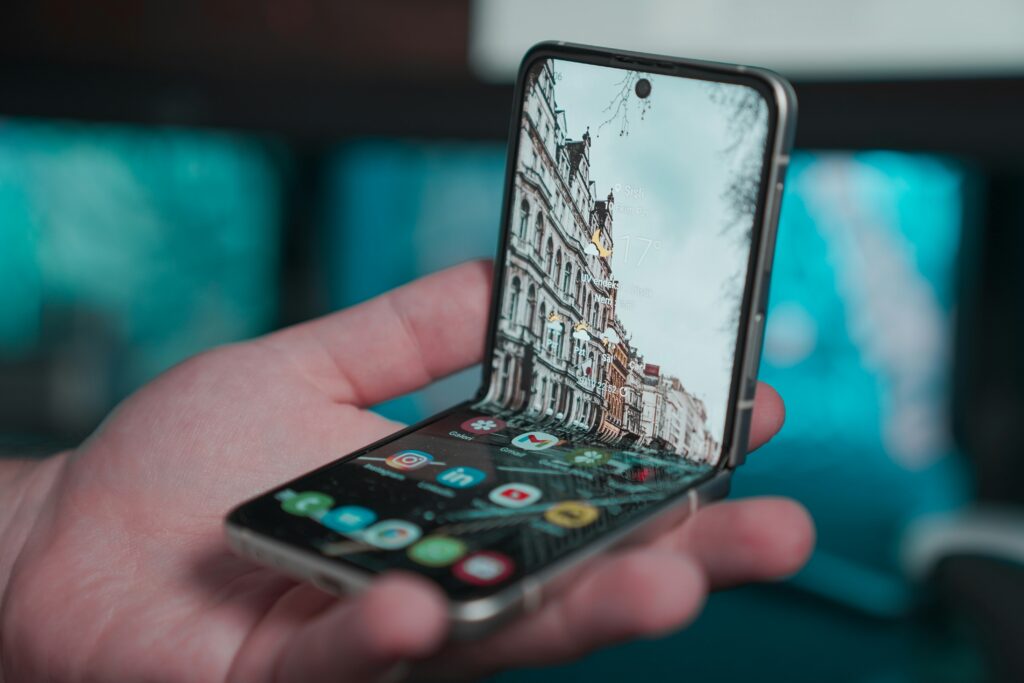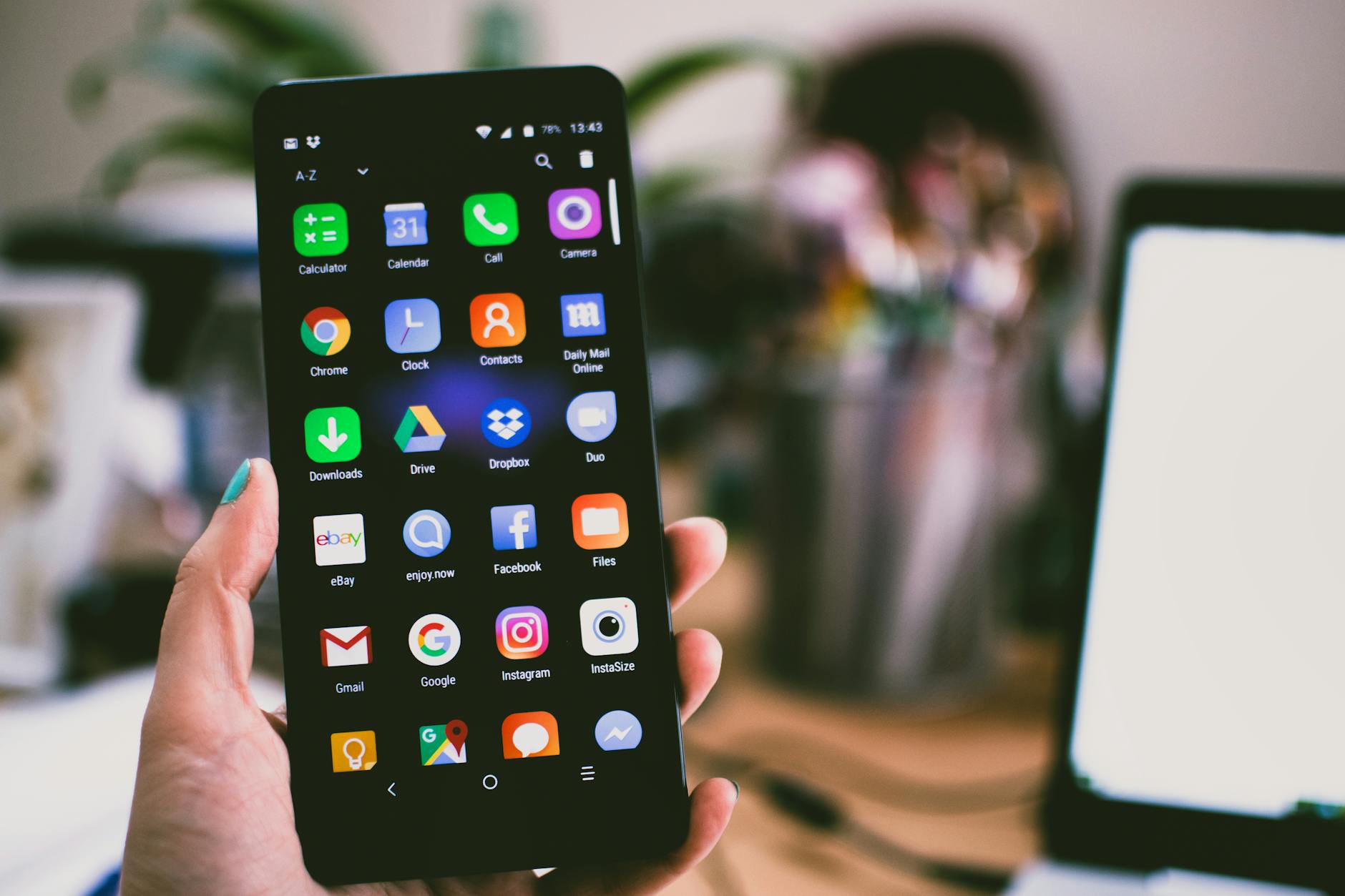Introduction to the future of smartphones
As we stand on the precipice of a new era in mobile technology, the future of smartphones is poised to revolutionize the way we interact with our digital world. The relentless pursuit of innovation has led to remarkable advancements in screen technology, paving the way for a paradigm shift in the realm of mobile devices. From the sleek and seamless foldable screens to the tantalizing possibilities that lie beyond, the future of smartphones promises an unparalleled level of versatility, functionality, and immersive experiences.
In this article, we will embark on an exciting journey, exploring the cutting-edge developments that are reshaping the landscape of smartphone technology. We will delve into the intricacies of foldable screens, unraveling their benefits and drawbacks, and uncover the potential applications that could redefine our daily lives. Furthermore, we will venture beyond the realm of foldable displays, unveiling emerging screen technologies that are pushing the boundaries of what we thought possible.
As we navigate through this captivating exploration, we will also address the challenges that accompany such groundbreaking innovations, shedding light on the obstacles that manufacturers and developers must overcome to bring these revolutionary concepts to fruition. Ultimately, we will contemplate the profound impact that foldable screens and other emerging technologies will have on smartphone design, shaping the devices of tomorrow into seamless extensions of our digital existence.
Evolution of smartphone screens
The evolution of smartphone screens has been a remarkable journey, marked by a relentless pursuit of technological advancement and user-centric design. From the humble beginnings of monochrome displays to the vibrant and immersive screens of today, each iteration has pushed the boundaries of what was once deemed impossible.
In the early days, smartphone screens were modest in size and resolution, serving primarily as a means to convey basic information and facilitate rudimentary interactions. However, as consumer demands grew and the possibilities of mobile computing expanded, the screens evolved to meet these heightened expectations.
We witnessed the rise of larger displays, offering more real estate for content consumption and multitasking. High-resolution screens, with pixel densities that rivaled the clarity of printed material, became the norm, ushering in a new era of visual fidelity. The advent of OLED technology further elevated the viewing experience, delivering deeper blacks, vivid colors, and improved power efficiency.

As smartphones became our constant companions, the need for durability and resilience grew. Manufacturers responded by introducing shatter-resistant glass and reinforced displays, ensuring that our devices could withstand the rigors of daily life. Simultaneously, the pursuit of sleeker and more compact form factors led to the development of bezel-less designs, maximizing the screen-to-body ratio and offering an immersive viewing experience.
With each iteration, smartphone screens have not only evolved in their technical specifications but also in their ability to seamlessly integrate into our lives, becoming indispensable tools for communication, productivity, and entertainment.
What are foldable screens?
Foldable screens, also known as flexible displays, represent a revolutionary leap in screen technology that has the potential to redefine the way we interact with our smartphones. These cutting-edge displays are designed to bend and fold without compromising their functionality, offering a unique combination of portability and versatility.
At the heart of foldable screens lies a groundbreaking material called polyimide, a flexible and durable plastic that serves as the foundation for the display. This material allows the screen to be bent and folded without causing permanent damage or distortion. Additionally, advanced display technologies, such as OLED and AMOLED, are employed to ensure that the folding process does not compromise image quality or color accuracy.
Foldable screens can take on various form factors, each with its unique advantages and applications. Some designs feature a single, continuous display that can be folded inward, transforming a compact device into a larger screen for enhanced productivity or multimedia consumption. Others incorporate multiple displays connected by a hinge, allowing users to seamlessly transition between different modes and configurations.
Beyond their ability to fold, these innovative screens often boast features such as ultra-thin profiles, lightweight construction, and enhanced durability, making them well-suited for the demands of modern mobile computing.
Benefits and drawbacks of foldable screens
The introduction of foldable screens brings with it a myriad of benefits that have the potential to revolutionize the way we interact with our smartphones. However, like any groundbreaking technology, there are also challenges and drawbacks that must be carefully considered.
“The mobile phones of the future are expected to be even more closely embedded in our day-to-day lives than ever before. Predictions about the direction of smartphones from futurists and industry experts range from having moderate involvement to literally running our lives.”
Benefits:
- Increased Versatility: Foldable screens offer unparalleled versatility by allowing users to seamlessly transition between different screen sizes and form factors. This adaptability enables optimal viewing experiences for various tasks, such as productivity, multimedia consumption, and gaming.
- Portability: When folded, foldable smartphones become incredibly compact and portable, making them easy to carry in pockets or small bags. This convenience is particularly appealing for users who value mobility without compromising screen real estate.
- Multitasking Capabilities: With the ability to display multiple applications or windows simultaneously, foldable screens enhance multitasking capabilities, enabling users to effortlessly switch between tasks or view multiple sources of information at once.
- Immersive Experiences: The large, continuous display of foldable screens offers an immersive viewing experience, ideal for multimedia consumption, gaming, and augmented reality applications.
Drawbacks:
- Durability Concerns: While foldable screens are designed to withstand repeated folding and unfolding, there are concerns about their long-term durability and resistance to wear and tear.
- Cost: The advanced materials and manufacturing processes required for foldable screens make them significantly more expensive than traditional displays, potentially limiting their accessibility to a broader consumer base.
- Software Optimization: Optimizing software and applications to take full advantage of foldable screens’ unique capabilities presents challenges for developers, potentially leading to compatibility issues or suboptimal user experiences.
- Battery Life: The larger screen sizes and advanced display technologies used in foldable screens may result in increased power consumption, potentially impacting battery life and requiring more frequent charging.
As with any emerging technology, the benefits and drawbacks of foldable screens must be carefully weighed and addressed through ongoing research, development, and innovation.
Other emerging smartphone screen technologies
While foldable screens have captured the imagination of consumers and industry experts alike, they are not the only emerging screen technologies poised to reshape the future of smartphones. The relentless pursuit of innovation has given rise to several other exciting developments that promise to enhance our mobile experiences in unprecedented ways.
- Rollable Displays: Building upon the concept of flexibility, rollable displays take the idea of foldable screens a step further. These displays can be rolled up or unrolled, allowing for an adjustable screen size and enabling new form factors, such as smartphones that can transform into tablets or even larger displays.
- Holographic Displays: Imagine a future where your smartphone screen can project holographic images and interfaces into the real world. Holographic displays leverage advanced optics and projection technologies to create three-dimensional, interactive displays that blur the line between digital and physical realities.
- Transparent Displays: Transparent displays have the potential to revolutionize the way we interact with our surroundings. By rendering digital content on a transparent surface, these displays can overlay information onto the real world, enabling augmented reality applications and enhancing our perception of the environment around us.
- Self-Healing Displays: Accidental scratches and cracks can be a frustrating reality for smartphone users. However, self-healing displays aim to address this issue by incorporating materials that can automatically repair minor damage, ensuring a flawless viewing experience over time.
- Stretchable Displays: Taking flexibility to the next level, stretchable displays are designed to conform to curved surfaces and even stretch or deform without compromising their functionality. This technology could pave the way for wearable devices with seamless, form-fitting displays or smartphones with unique, organic shapes.
These emerging screen technologies, while still in various stages of development, offer a glimpse into the exciting possibilities that await us in the future of mobile computing. As research and innovation continue to push the boundaries, we can expect even more groundbreaking advancements that will reshape our perceptions of what a smartphone screen can be.
Potential applications of foldable screens
The introduction of foldable screens opens up a world of possibilities and potential applications that extend far beyond the realm of traditional smartphones. These innovative displays have the power to revolutionize various industries and reshape the way we interact with technology in our daily lives.
- Productivity and Multitasking: Foldable screens offer a versatile solution for professionals and power users who demand enhanced productivity and multitasking capabilities. With the ability to seamlessly transition between different screen sizes and configurations, users can effortlessly switch between tasks, view multiple applications simultaneously, and optimize their workflow for maximum efficiency.
- Multimedia and Entertainment: The large, continuous display provided by foldable screens creates an immersive experience for multimedia consumption and gaming. Imagine watching movies or playing games on a device that can unfold to reveal a theater-like viewing experience, or folding it back into a compact form factor for on-the-go entertainment.
- Education and E-Learning: Foldable screens have the potential to revolutionize the way we learn and access educational resources. Interactive textbooks, virtual classrooms, and immersive educational experiences can be enhanced by the flexibility and versatility of these displays, making learning more engaging and accessible.
- Augmented Reality (AR) and Virtual Reality (VR): The combination of foldable screens and AR/VR technologies opens up new frontiers in immersive experiences. Foldable devices can serve as portable gateways to virtual worlds, offering a compact and convenient way to access augmented and virtual realities for gaming, training, and exploration.
- Healthcare and Medical Applications: Foldable screens could revolutionize the way medical professionals access and interact with patient data, medical imaging, and diagnostic tools. Portable and versatile displays could enhance telemedicine services, enable remote consultations, and provide a more efficient and accessible means of delivering healthcare.
- Retail and Advertising: Imagine interactive displays that can fold and unfold to showcase products, provide detailed information, or create immersive brand experiences. Foldable screens could revolutionize the way retailers and advertisers engage with customers, offering dynamic and attention-grabbing displays that captivate and inform.
These are just a few examples of the potential applications of foldable screens. As this technology continues to evolve and mature, we can expect even more innovative use cases to emerge, pushing the boundaries of what we thought possible and reshaping the way we interact with technology in our daily lives.

Challenges in the development of foldable screens
While the promise of foldable screens is undeniably captivating, the path to widespread adoption and commercial success is not without its challenges. Manufacturers and developers must navigate a complex landscape of technical, design, and user experience considerations to bring these innovative displays to market successfully.
- Durability and Longevity: One of the primary challenges in the development of foldable screens is ensuring their long-term durability and resistance to wear and tear. The repeated folding and unfolding of the display can potentially lead to stress on the materials, increasing the risk of creasing, delamination, or other forms of damage over time. Addressing these durability concerns is crucial for building consumer confidence and ensuring a positive user experience.
- Manufacturing and Production Challenges: The production of foldable screens requires advanced manufacturing techniques and specialized materials, which can be complex and costly. Achieving consistent quality, yield rates, and scalability in the manufacturing process is a significant challenge that must be overcome to make foldable screens widely available and affordable.
- Software Optimization and User Experience: Optimizing software and applications to take full advantage of the unique capabilities of foldable screens is a significant challenge for developers. Ensuring a seamless and intuitive user experience across different screen configurations and form factors requires careful consideration and extensive testing. Failure to address these software and user experience challenges could result in suboptimal or frustrating experiences for consumers.
- Battery Life and Power Consumption: The larger screen sizes and advanced display technologies used in foldable screens can lead to increased power consumption, potentially impacting battery life and requiring more frequent charging. Addressing this challenge may involve advancements in battery technology, power-efficient display components, and intelligent power management strategies.
- Design Considerations: Integrating foldable screens into sleek and ergonomic device designs presents unique challenges. Factors such as hinge mechanisms, device thickness, and overall form factor must be carefully considered to ensure a comfortable and practical user experience, while also maintaining aesthetic appeal.
- Ecosystem and Ecosystem Support: The success of foldable screens hinges on the development of a robust ecosystem, including compatible accessories, peripherals, and third-party software support. Building and fostering this ecosystem requires collaboration between manufacturers, developers, and industry partners to ensure a seamless and cohesive experience for users.
Overcoming these challenges will require continued innovation, collaboration, and a deep understanding of user needs and preferences. As the technology matures and industry players address these hurdles, foldable screens will become more accessible, reliable, and seamlessly integrated into our daily lives.
The impact of foldable screens on smartphone design
The introduction of foldable screens is poised to have a profound impact on the design and functionality of smartphones, ushering in a new era of versatility and innovation. As this groundbreaking technology continues to evolve, it will reshape the way we perceive and interact with our mobile devices, blurring the lines between traditional form factors and opening up new realms of possibility.
- Form Factor Flexibility: One of the most significant impacts of foldable screens is the ability to create devices with dynamic and adaptable form factors. Smartphones can now seamlessly transition between compact and portable configurations to larger, tablet-like displays, offering users the best of both worlds in a single device. This flexibility allows for optimized experiences tailored to specific use cases, such as productivity, multimedia consumption, or gaming.
- Ergonomic Considerations: The advent of foldable screens has prompted a reevaluation of ergonomic design principles in smartphones. Manufacturers must carefully consider factors such as device thickness, hinge mechanisms, and overall weight distribution to ensure a comfortable and natural user experience, regardless of the screen configuration.
- Multitasking and Productivity Enhancements: With the ability to display multiple applications or windows simultaneously, foldable smartphones offer enhanced multitasking capabilities. Users can effortlessly switch between tasks, view multiple sources of information at once, or even run different applications on separate screens, boosting productivity and efficiency.
- Immersive Multimedia Experiences: The large, continuous display provided by foldable screens creates an immersive viewing experience for multimedia consumption. Movies, games, and other forms of entertainment can be enjoyed on a larger canvas, offering a more captivating and engaging experience without the need for additional devices.
- Innovative User Interfaces and Interactions: The unique form factors and capabilities of foldable screens necessitate the development of innovative user interfaces and interaction models. Designers and developers must rethink traditional paradigms and explore new ways to leverage the flexibility and versatility of these displays, creating intuitive and seamless experiences tailored to the foldable form factor.
- Ecosystem Integration: The success of foldable smartphones will depend on the development of a robust ecosystem, including compatible accessories, peripherals, and third-party software support. Manufacturers must work closely with industry partners and developers to ensure a cohesive and seamless experience across the entire ecosystem.
As foldable screens continue to evolve and become more mainstream, their impact on smartphone design will only deepen. Manufacturers will be challenged to push the boundaries of innovation, creating devices that not only embrace the unique capabilities of foldable displays but also anticipate and exceed the evolving needs and expectations of consumers.
“The smartphone of the future will be more than just a device; it will be a distributed experience, seamlessly integrating AI, advanced security, and innovative form factors to redefine how we interact with technology and the world around us.”
The future of smartphones beyond foldable screens
While foldable screens have captured the imagination of consumers and industry experts alike, the future of smartphones extends far beyond this groundbreaking technology. The relentless pursuit of innovation has given rise to a multitude of exciting developments that promise to reshape the way we interact with our mobile devices and redefine the very concept of a smartphone.
- Augmented Reality (AR) and Mixed Reality (MR): The integration of augmented reality and mixed reality technologies into smartphones has the potential to blur the lines between the digital and physical worlds. Imagine being able to overlay digital information, interactive interfaces, and virtual objects onto the real world, creating immersive and contextual experiences that enhance our perception of reality.
- Artificial Intelligence (AI) and Machine Learning: The integration of advanced AI and machine learning capabilities into smartphones will enable a new level of intelligent assistance and personalization. From predictive analytics and context-aware recommendations to enhanced security and seamless device interactions, AI will transform the way we interact with our mobile devices, making them truly intelligent companions.
- 5G and Beyond: The advent of 5G and future generations of wireless technology will revolutionize the way we connect and access information on our smartphones. With blazing-fast data speeds, ultra-low latency, and improved network capacity, new possibilities will emerge, such as real-time cloud computing, seamless streaming of high-quality content, and the enablement of advanced applications like remote surgery and autonomous vehicle control.
- Biometric Authentication and Security: As our smartphones become increasingly integrated into our daily lives, the need for robust security measures becomes paramount. Advancements in biometric authentication technologies, such as facial recognition, iris scanning, and fingerprint sensors, will provide enhanced security and privacy, while also offering seamless and convenient access to our devices.
- Sustainable and Eco-Friendly Design: As environmental concerns continue to grow, the demand for sustainable and eco-friendly smartphone design will become increasingly important. Manufacturers will be challenged to incorporate recyclable materials, reduce electronic waste, and optimize energy efficiency, creating devices that not only perform exceptionally but also minimize their environmental impact.
- Modular and Customizable Devices: The future of smartphones may also embrace a modular approach, allowing users to customize and upgrade specific components of their devices according to their needs and preferences. This could include swappable cameras, additional storage, or even specialized modules for specific tasks, such as gaming or productivity, creating a truly personalized and future-proof mobile experience.
- Advanced Sensor Integration: The integration of advanced sensors into smartphones will open up new realms of functionality and data collection. From environmental sensors that monitor air quality and radiation levels to health-tracking sensors that measure vital signs and biometric data, our smartphones will become powerful tools for monitoring and understanding our surroundings and ourselves.
- Wearable and Implantable Technologies: As the boundaries between technology and the human body continue to blur, we may witness the emergence of wearable and implantable technologies that seamlessly integrate with our smartphones. From smart clothing and augmented reality glasses to implantable devices that monitor health or enhance cognitive abilities, the future of smartphones may extend beyond the traditional handheld form factor.
- Quantum Computing and Advanced Encryption: The advent of quantum computing and advanced encryption technologies could revolutionize the way we secure and process data on our smartphones. With the ability to perform complex calculations and decrypt even the most sophisticated encryption algorithms, quantum computing could usher in a new era of secure communication, data protection, and advanced computational capabilities on mobile devices.
These are just a few glimpses into the future of smartphones beyond foldable screens. As technology continues to evolve at a rapid pace, the possibilities are endless, and the devices we carry with us will become increasingly powerful, intelligent, and integrated into every aspect of our lives.

Conclusion: The exciting future of smartphone technology
As we stand on the precipice of a new era in mobile technology, the future of smartphones promises to be an exhilarating journey filled with groundbreaking innovations, immersive experiences, and seamless integration into our daily lives. From the revolutionary foldable screens that offer unparalleled versatility to the tantalizing possibilities that lie beyond, the devices we carry with us will continue to push the boundaries of what we thought possible.
The advent of foldable screens represents a significant milestone in the evolution of smartphone technology, offering a unique combination of portability and expansive screen real estate. As manufacturers and developers continue to refine and perfect these innovative displays, we can expect to witness a transformation in the way we interact with our digital world, blurring the lines between traditional form factors and opening up new realms of productivity, entertainment, and immersive experiences.
However, the future of smartphones extends far beyond foldable screens. The integration of advanced technologies such as augmented reality, artificial intelligence, and quantum computing will redefine the very concept of a smartphone, transforming these devices into intelligent companions that seamlessly integrate into every aspect of our lives.
As we navigate this exciting landscape, it is crucial to address the challenges that accompany such groundbreaking innovations. From ensuring long-term durability and optimizing software experiences to fostering a robust ecosystem and addressing sustainability concerns, the path to widespread adoption requires a collaborative effort from manufacturers, developers, and industry partners.
Ultimately, the future of smartphones promises to be a transformative journey, one that will reshape the way we perceive and interact with technology. As consumers, we can look forward to a world where our mobile devices become seamless extensions of our digital existence, offering unparalleled versatility, intelligence, and immersive experiences that transcend the boundaries of what we thought possible.As we stand at the forefront of this technological revolution, I invite you to embrace the future of smartphones with open arms. Stay curious, explore the possibilities, and be part of the exciting journey that lies ahead. Together, we can shape the future of mobile technology and unlock a world of unprecedented connectivity, productivity, and wonder.
Unlocking the Power of Blockchain Technology: How This Revolutionary Technology is Transforming Industries
Navigating the Crypto World: A Comprehensive Comparison of Proof of Stake vs Proof of Work
From Traditional to Modern: The Unavoidable Shift to Digital Business Transformation


